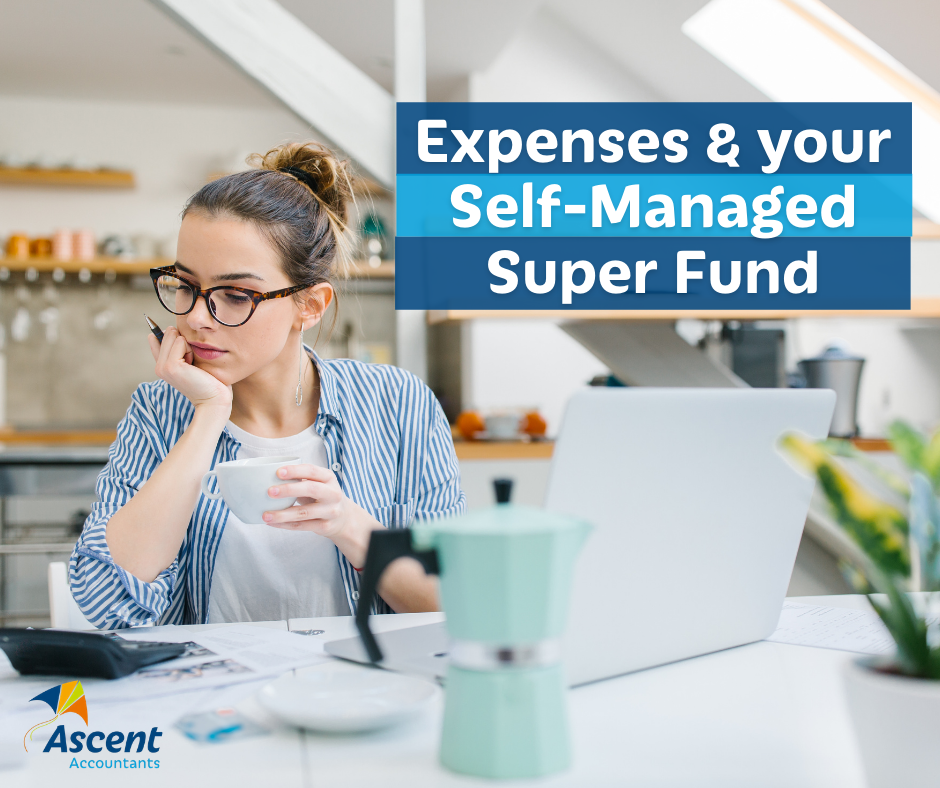Expenses & Your Self-Managed Super Fund

Retirement is pretty much every Aussie’s end goal, but it can also be a daunting idea because of the lack of regular income. Luckily the government has implemented measures to encourage people to plan for their eventual retirement. The biggest way they have done this is through compulsory contributions to retirement savings into Superannuation over an individual’s working life.
While plenty of people chose to go with specific Super Funds, you are also able to self-manage if you would prefer. Self-Managed Super Funds can be great for many reasons, such as flexibility, control, effective tax management, accountability and a wider range of investment choices.
Self-Managed Super Funds can be tempting, but the claiming of expenses on them can be tricky business. There are so many things you need to ask yourself. What is an allowable expense of the fund? What is actually tax deductible?
Any costs or expenses must be allowable under the Superannuation law & fund deed, and Self-Managed Super Fund operations and investment strategy.
The biggest question you will need to ask yourself is – do the costs and expenses relate to the provision of retirement benefits?
All Self-Managed Super Fund expenses will need to be recorded and reported in your fund’s financial statements. Any fund expenses that are paid by members where no claim for reimbursement is made will also need to be recorded as an expense in the fund.
Typical expenses that can be claimed as tax deductions in a Self-Managed Super Fund would generally include:
Operating expenses
Include items like accounting, taxation, audit and actuarial fees.
Statutory fees
Include The annual Australian Taxation Office supervisory levy as well as the Australian Securities and Investments Commission’s annual fees.
Investment Expenses
These would include items such as ongoing management fees, bank fees, interest for limited resource borrowings, property insurance and other rental property expenses. You can also potentially claim financial advice when it relates to a mix of investments from the Self-Managed Super Fund and is not a new plan or strategy. You will need to keep in mind that other investment costs such as brokerage fees are not tax deductible (but instead for part of the asset cost base for capital gains tax purposes).
Legal expenses
These kinds of expenses can be a bit more tricky to navigate. Legal advice may be deductible or capital in nature, depending on the type of advice and services provided.
Trust Deed Updates
These can be made tax deductible only if the update is to ensure that the Self-Managed Super Fund complies with the changes to the superannuation legislation. Other changes will be considered a capital cost.
Member insurance
Certain member insurances can be paid by the Self-Managed Super Fund and then claimed as a tax deduction. These include life and disability cover.
Extra investments
People will often try to claim extra investment expenses such as laptops, subscriptions, and seminars. Be careful with these as the expenses can only be claimed if they directly relate to the running of your Self-Managed Super Fund. Unlike personal tax claims, you can’t have partial personal use and part tax deductible claims in the Self-Managed Super Fund.
Try to avoid falling into the trap of trying to claim everything you can as an expense for your Self-Managed Super Fund because the funds are audited. Ask yourself these questions
- Does this expense relate to the operation of my Self-Managed Super Fund?
- Is it TRULY an expense of my Self-Managed Super Fund?
- Is it for the sole purpose of my Self-Managed Super Fund?
- Is the expense tax deductible or a capital cost?
If you are in doubt, please feel free to contact us. We would love to help!
Phone: 08 6336 6200
Email: info@ascentwa.com.au
Need help with your accounting?

The Australian Government’s expanded 5% Deposit Scheme, which commenced on October 1, offers a fast-tracked path to home ownership for many aspiring buyers. By drastically reducing the deposit required and eliminating Lenders Mortgage Insurance (LMI), this program aims to unlock the door to your very own home sooner than ever thought possible. However, like any major economic policy, it has significant implications that buyers and taxpayers must consider. Here is a breakdown of how the scheme works, who qualifies, and what the potential impact could be on the property market. What is the 5% Deposit Scheme and how does it work? The scheme is designed to make home ownership more achievable, particularly for those struggling to save a 20% deposit. Low Deposit: The home buyer secures a loan with a minimum deposit of 5% (for First Home Buyers) or 2% (for single parents/legal guardians). Government Guarantee: Instead of the buyer paying LMI (which protects the lender), the Australian Government provides a guarantee to a Participating Lender. This guarantee allows the lender to provide a home loan covering up to 95% or 98% of the home's value without the usual LMI fee. No LMI: The buyer avoids paying Lenders Mortgage Insurance, significantly reducing upfront costs. Key features of the expanded program include no income caps, as well as unlimited spots and no waiting list. The Scheme also makes a wider choice of home types available (houses, apartments, house/land packages, vacant land with a building contract, new or existing homes). It’s not just for first home buyers!

Christmas can be the most wonderful time of the year—it can also be one of the most expensive. The key to enjoying the festive season and reducing the risk of financial stress is careful planning. As your financial partners at Ascent Accountants, we want you to focus on what truly matters—time with friends, family, and peace of mind. Six essential budgeting tips to help you take control of your Christmas spending. 1. Make a detailed budget list. The sooner you start, the more control you have. Begin by listing every expense you anticipate, including gifts, food, clothes, travel, and entertainment. Once you have your total, check it against your available funds. If the total feels too high, look at where you can cut back or spread the cost. Being realistic from the beginning prevents surprises later. 2. Prioritise what truly matters (and pay your priority debts!). When money is tight, focus your funds on the essentials and the things that genuinely bring the most joy. Order your list by priority (e.g., gifts for children first, then shared family meals, then travel). It’s okay—and essential—to say 'no' to extras that don’t fit your budget. Always consider your priority payments and debts before any other Christmas spending. Priority debts, like rent, electricity, or car insurance, must always come first as they significantly impact your day-to-day life if left unpaid. 3. Be cautious with credit and 'Buy Now, Pay Later' arrangements. It's tempting to use a credit card or a Buy Now, Pay Later option, especially when promotions promise delayed payments. However, small instalments add up quickly, and missing a payment can result in fees and/or negatively impact your credit record. If you do use credit, only borrow what you can comfortably afford to repay, and make a solid plan to pay it off as soon as possible in the new year. 4. Compare prices & shop smart. Always take time to research before you buy. Comparing online and in-store prices can result in significant savings. Be wary of high-pressure sales events like Black Friday, which often encourage impulse spending. Before purchasing, ask yourself three questions: Do I really need this? Is this on my original budget list, or is it extra? Is this truly a bargain if I don't actually need it? 5. Suggest a 'Secret Santa'. If your family or friend group has traditionally bought gifts for everyone, suggest switching to a Secret Santa arrangement. Setting a sensible spending limit or pooling funds for one thoughtful gift makes things easier and less expensive for everyone. Often, homemade gifts or vouchers for experiences are more meaningful and last longer in the memory than expensive presents. 6. Plan ahead for next year. The best way to guarantee a calm, affordable Christmas next year is to start preparing now. After this year's holidays, take note of exactly what you spent and where the money went. Set a goal for next year and start a small savings fund. Even setting aside $5 or $10 a week can make a monumental difference in managing next Christmas without stress. Need to tidy up your finances after the holidays? If the Christmas period leaves you needing advice on debt consolidation, setting up a savings plan, or just better budgeting habits for the new year, contact the team at Ascent Accountants. We can help you build the confidence to hit your financial goals!

As the end of the year approaches, businesses are gearing up for the festive season, which means planning the annual Christmas party and showing appreciation with gifts. While the cheer is high, so too are the complexities of Fringe Benefits Tax (FBT). Getting the FBT treatment wrong can turn a simple celebration into an unexpected tax bill. As your trusted advisors at Ascent Accountants, here is a breakdown of the key tax rules, with a focus on the crucial $300 per person limit, to ensure your end-of-year generosity is tax-effective. The critical $300 minor benefit threshold. The Minor Benefits Exemption is your best friend for managing FBT. A benefit is generally exempt from FBT if its total notional taxable value is less than $300 (GST inclusive) per person, and it is provided infrequently and irregularly. Christmas parties (entertainment) The location and cost of your party are the key factors for FBT.

If your business interacts with the public in any way (from welcoming customers into your shop to visiting client sites) then public liability insurance isn’t just “nice to have.” It’s essential protection. Whether you’re a sole trader, a café owner, or running a construction company, public liability insurance helps safeguard your business against unexpected (and often costly) accidents. What Is public liability insurance? Public liability insurance covers your business if a member of the public suffers injury, death, or property damage as a result of your business activities. In simple terms, it’s there to protect you financially if something goes wrong—such as a customer slipping in your store, a tradie damaging a client’s property, or a product you sell causing harm. Without it, you could be personally liable for significant compensation and legal costs. What does it cover? A typical policy covers: Injury or death to a third party caused by your business operations. Damage to property belonging to someone else. Compensation and legal costs you’re ordered to pay following a covered claim. For example, if a customer trips over a cable in your office or a carpenter cracks a client’s TV while working onsite, public liability insurance steps in to cover the costs. What isn’t covered? While every policy is different, public liability insurance usually won’t cover: Damage involving vehicles. Defective work. Breach of professional duty or negligence in advice (that’s covered by professional indemnity insurance). Defamation or advertising liability. Understanding these exclusions helps you choose the right combination of cover for your business. Who needs public liability insurance? If your business has any level of public interaction, you likely need it. Common examples include: Customer or supplier visits: If anyone comes to your premises or you work on theirs. Public events: Markets, expos, and pop-ups. Retail, trade, and construction: High public contact increases your risk. Leased premises: Many shopping centres and landlords require proof of cover. Contractor or license requirements: Many trade licenses (like electricians and plumbers) require it to operate. Even if it’s not legally required, most Australian businesses choose to have public liability insurance for peace of mind. How much cover do you need? The level of cover depends on your industry, business size, and risk exposure. Most businesses opt for between $5 million and $20 million. It’s worth reviewing your policy regularly, especially if your operations expand or you start working in new environments. Is it compulsory in Australia? Public liability insurance isn’t legally mandatory for all businesses, but some industries and licences make it a condition of operation. For example, in Queensland, electrical contractors must hold a minimum of $5 million in public and product liability cover. Similarly, councils or venue owners may require proof of insurance before approving an event or leasing a space. Don’t risk a law suit. Being sued for negligence can be financially devastating. Even a minor incident can mean you lose hundreds of thousands—not to mention the impact on your brand and business reputation. Public liability insurance ensures your business can keep operating, even when the unexpected happens. If you’re unsure whether your current cover is adequate, our team at Ascent Accountants can help you review your business risks and recommend the right level of protection for your situation. Contact us today to learn more.




